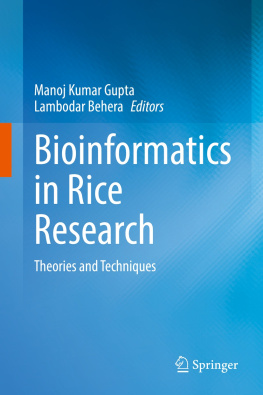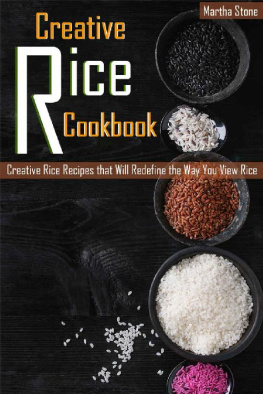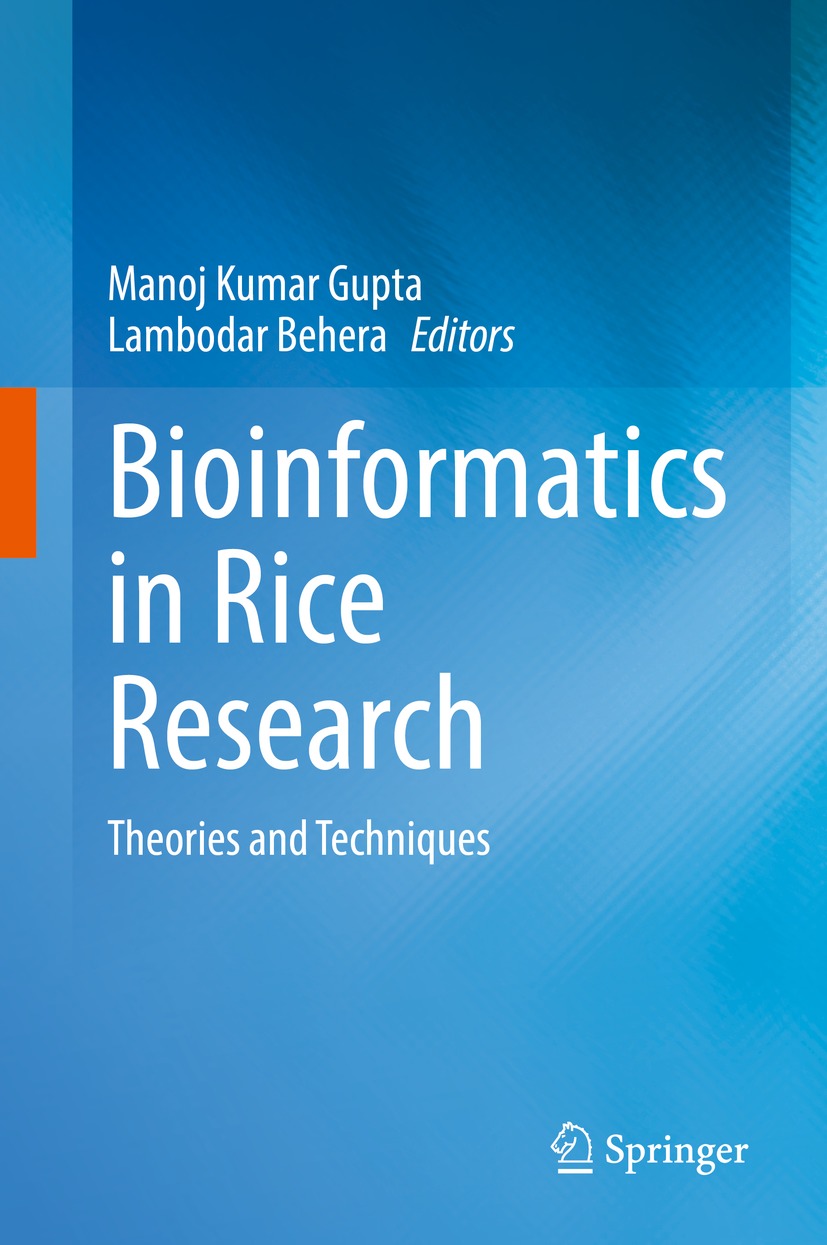Editors
Manoj Kumar Gupta and Lambodar Behera
Bioinformatics in Rice Research
Theories and Techniques
1st ed. 2021

Logo of the publisher
Editors
Manoj Kumar Gupta
Crop Improvement Division, ICAR-National Rice Research Institute, Cuttack, Odisha, India
Lambodar Behera
Crop Improvement Division, ICAR-National Rice Research Institute, Cuttack, Odisha, India
ISBN 978-981-16-3992-0 e-ISBN 978-981-16-3993-7
https://doi.org/10.1007/978-981-16-3993-7
The Editor(s) (if applicable) and The Author(s), under exclusive licence to Springer Nature Singapore Pte Ltd. 2021
This work is subject to copyright. All rights are solely and exclusively licensed by the Publisher, whether the whole or part of the material is concerned, specifically the rights of translation, reprinting, reuse of illustrations, recitation, broadcasting, reproduction on microfilms or in any other physical way, and transmission or information storage and retrieval, electronic adaptation, computer software, or by similar or dissimilar methodology now known or hereafter developed.
The use of general descriptive names, registered names, trademarks, service marks, etc. in this publication does not imply, even in the absence of a specific statement, that such names are exempt from the relevant protective laws and regulations and therefore free for general use.
The publisher, the authors and the editors are safe to assume that the advice and information in this book are believed to be true and accurate at the date of publication. Neither the publisher nor the authors or the editors give a warranty, expressed or implied, with respect to the material contained herein or for any errors or omissions that may have been made. The publisher remains neutral with regard to jurisdictional claims in published maps and institutional affiliations.
This Springer imprint is published by the registered company Springer Nature Singapore Pte Ltd.
The registered company address is: 152 Beach Road, #21-01/04 Gateway East, Singapore 189721, Singapore
Dr. Manoj Kumar Gupta and Dr. Lambodar Behera dedicate this book to every member of Gupta, Behera, and Benzenberg families for their endless love, inspiration, and motivation.
Preface
In the genomics era, bioinformatics, a discipline that uses data from molecular sequence (nucleotide and protein) research to make observations regarding biological functions and entails the application of information technology to biology, has grown exponentially. It is now an integral part of biological research, with applications in a wide range of fields. Bioinformatics is expanding in tandem with rapid technical and scientific advancements in a variety of fields. The science of big data is the product of collaboration between ultrahigh-throughput technological growth and high-performance computers. In recent years, genetics, genomics, proteomics, metabolomics, and metagenomics have had a greater impact on biology. The Human Genome Project resulted in next-generation sequencing technologies, which allow for whole-exome and whole-genome sequencing (NGS) in as little as 2456 h. This changed the way of unusual disorder genetic testing all over the world. Almost every nation has scientists who can analyse NGS data for diagnostic purposes. The world would profit enormously from the decoding of plant and animal genomes. Bioinformatics methods would be useful for looking and explaining the roles of genes that are useful to the agricultural population inside certain genomes. This basic genetic information would be useful for the development of crops that are more drought, disease, and insect tolerant, as well as increase livestock production by making them better, disease-resistant, and more profitable.
Bioinformatics in Rice Research: Theories and Techniques provides an up-to-date review of various classical and advanced bioinformatics and molecular biology approaches that are used in various biological fields. This book comprises 26 chapters divided into 3 parts. The first part describes in brief the importance of bioinformatics and statistics in biological research. This part also gives a brief idea about various rice varieties and biological databases that have been developed for a better understanding of the rice genome complexity. In the second part, various tools and techniques for bioinformatics analysis of genomic and proteomic sequences have been discussed in detail. In the third part, principles and techniques of various high-throughput technologies have been described. All chapters in this book also aim at scientists/researchers who are interested in developing bioinformatics tools. These books will be highly useful for both beginners and experienced bioinformaticians interested in solving biological questions.
Manoj Kumar Gupta
Lambodar Behera
Cuttack, Odisha, India
Acknowledgements
At first, we, the editors, would like to express our gratitude to God, Almighty, who gave us wisdom, health, knowledge, strength, and energy to succeed in our dream of writing a book. We are thankful to the Director and Head of the Division of Crop Improvement of ICAR-National Rice Research Institute (formerly CRRI), Cuttack, Odisha, India, for providing inspiration and motivation. We also express our sincere thanks to Dr. Ramakrishna Vadde, Associate Professor, Department of Biotechnology and Bioinformatics, Yogi Vemana University, for his inspiration, valuable suggestions, and guidance on some chapters. We also thank Mr. Jan Benzenberg, Incident Manager, Carrier Radio Access Network (Germany), for his valuable guidance, inspiration, encouragement, and indefatigable attitude that helped us throughout the journey of writing and preparing this manuscript.
This book would not have been possible without the authors and co-authors who supported in writing the chapters. We feel immense pleasure to express our gratitude to all authors and co-authors for writing and successfully completing it within time. We heartily appreciate the team members, especially, Dr. Gayatri Gouda, Dr. Ravindra Donde and Mr. S. Sabarinathan, for arranging the manuscripts.
We want to acknowledge Springer Nature (Publisher) for accepting our book proposal and showing interest in publishing it.
Contents
Part I Introduction
Manoj Kumar Gupta and Lambodar Behera
Manoj Kumar Gupta , Gayatri Gouda , Ravindra Donde , S. Sabarinathan , Goutam Kumar Dash , Menaka Ponnana , Pallabi Pati , Sushil Kumar Rathore , Ramakrishna Vadde and Lambodar Behera
Gayatri Gouda , S. Sabarinathan , Ravindra Donde , Goutam Kumar Dash , Menaka Ponnana , Manoj Kumar Gupta , Ramakrishna Vadde , Lambodar Behera and Trilochan Mohapatra
Manoj Kumar Gupta , Gayatri Gouda , S. Sabarinathan , Ravindra Donde , Goutam Kumar Dash , Menaka Ponnana , Pallabi Pati , Sushil Kumar Rathore , Ramakrishna Vadde and Lambodar Behera
Manoj Kumar Gupta , Gayatri Gouda , Ravindra Donde , S. Sabarinathan , Goutam Kumar Dash , N. Rajesh , Menaka Ponnana , Pallabi Pati , Sushil Kumar Rathore , Ramakrishna Vadde and Lambodar Behera
Part II Bioinformatics Analysis of Genomic and Proteomic Sequences













